Last Chance to Catch NYC's Holiday Notalgia Train
We met the voices of the NYC subway on our nostalgia ride this weekend!


“Renewal doesn’t mean transformation, it’s about rehabilitation. It means we have to restore the buildings.”
-Deputy Mayor of Fatih Municipality, March 15th, 2011.
In a closed-door meeting, the deputy mayor of Fatih Municipality clarified the aim of controversial Law No. 5366 for us, an urban planning studio from Columbia University. Passed in 2005, its formal name is “Preservation by Renovation and Utilization by Revitalizing of Deteriorated Immovable Historical and Cultural Properties.” However, the law is popularly referred to as the “Urban Renewal Act” by community groups in Istanbul, who argue that it is used in practice as a tool for mass urban renewal and gentrification.
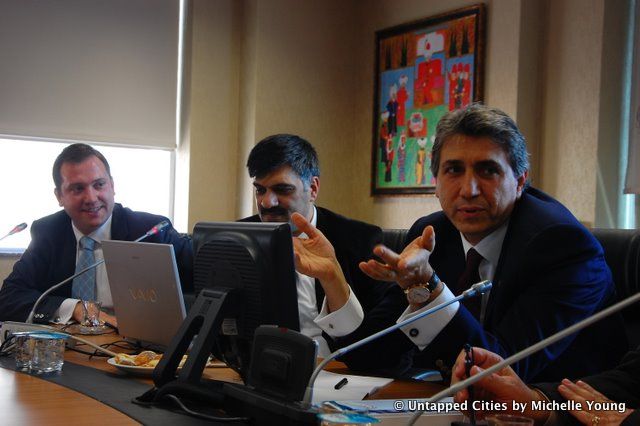 Mayor Mustafa Demir (right) of Fatih Municipality, Deputy Mayor (center), translator (left)
Mayor Mustafa Demir (right) of Fatih Municipality, Deputy Mayor (center), translator (left)
Istanbul is also under fire from UNESCO for its lax enforcement of preservation. The city was declared a World Heritage Site in 1985, with the entire historic peninsula protected. Four priority zones were mapped out including the Topkapi Palace and environs, the Suleymaniye area, Zeyrek historical neighborhood and the old Byzantine city walls. The local municipality then drew up its own preservation map, which neither matched the UNESCO boundaries nor seemed to respect the extent of protection desired by the international organization, particularly around the ancient city walls. The cause behind this discrepancy is unclear, but it is known that UNESCO maps were not provided to local municipalities by the Ministry of Culture until 2003. [1] In a report from 2006, UNESCO also expressed concern regarding the quality of reconstruction being done as well as the tendency to demolish and rebuild in the style of the old-with concrete clad by wood, in imitation of the Byzantine timber house aesthetic. [1]
When we met with the IMP (Istanbul Metropolitan Planning and Urban Design Center), the officials agreed with UNESCO’s analysis. Unfortunately, it seemed that the IMP had been divested of much of its authority after political strife with the Istanbul mayor and was serving primarily as a research facility rather than a body of enforcement. It’s staff had been significantly cut and the office was eerily empty. Under Law 5366, the local municipalities have full control over development once an area is declared a renewal zone, further rendering the role of the IMP obsolete.
 Sulukule (right) before demolition. Image via Wikimedia Commons.
Sulukule (right) before demolition. Image via Wikimedia Commons.
One of the first initiatives under Law 5366 was Sulukule, a traditionally Roma (gypsy) neighborhood dating back to the Byzantine era. Sulukule was reportedly the first area in the world to be permanently settled by a Roma population. The neighborhood is 22 acres in size and is situated along the Byzantine Walls in a UNESCO priority protection zone. For centuries, the neighborhood served as a music and dance cultural destination for the city, open to Istanbul residents and visitors alike. The neighborhood was also characterized by a spatial pattern unique to Istanbul, featuring housing units that surroundedgent actively used courtyards and gardens for informal and family activities. However, the neighborhood had suffered economic decline and the homes were in varying states of disrepair.
In 2008, the UNESCO World Heritage Committee criticized the Sulukule Renewal Project as a “gentrification project” and recommended “that a balance must be found between conservation, social needs and identity of the community.” [2] According to Aslà”ž ± Kà”ž ±yak à”ž °ngin of the Sulukule Platform, the neighborhood was also “highly stigmatized in the minds of the mainstream populations mainly as being a host to drug users and traders” and was thus a prime target for an urban renewal project. [3] The entertainment houses were forcibly closed in 1992 on grounds of prostitution, immorality and thievery. Sulukule was designated an urban renewal zone in 2005 and Prime Minister Erdoà”žà… ¸an announced, “We will save Sulukule from its state of aberration.” (2008) [4]
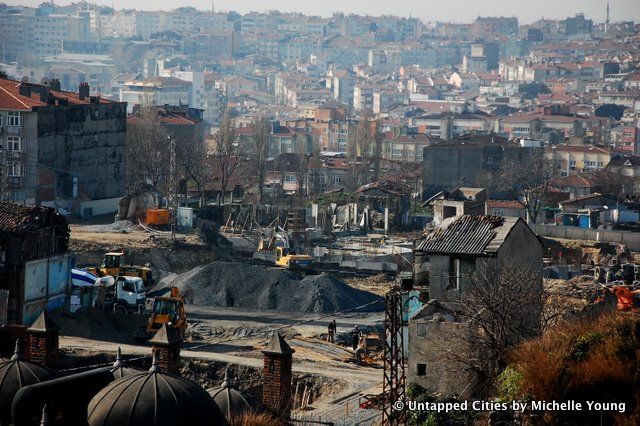 Sulukule Today
Sulukule Today
On the other hand, the deputy mayor of Fatih Municipality emphasized the “flexibility” of the law, which he contended was one of its strengths. The law could be applied as needed, depending on the situation. In Sulukule, this meant relocating the 5,000 families who lived there to Tasoluk, a TOKI social housing complex 30 kilometers away, providing them with free transportation back to the city and some “cash,” according to the deputy mayor. In the end, ┦” of the residents never moved into Tasoluk, finding the rents and maintenance fees unaffordable and the location too far from their livelihood. The adjustment from a low-rise communal lifestyle to the high-rise housing apartments was also untenable for the residents and many resettled near Sulukule.
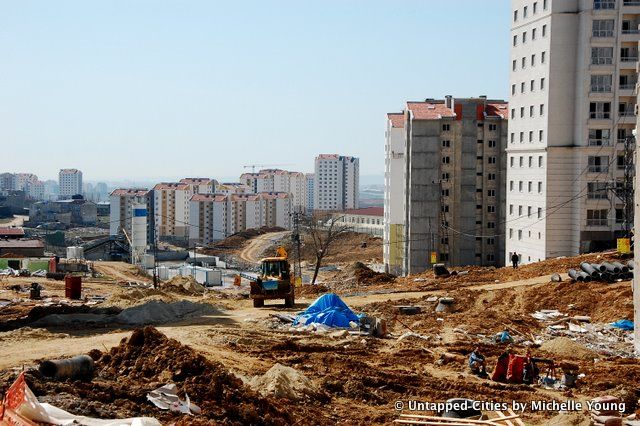 TOKI Housing under construction in the Suburbs (not Tasoluk)
TOKI Housing under construction in the Suburbs (not Tasoluk)
TOKI is the Housing Development Authority of Turkey which reports directly to the Office of the Prime Minister. In addition to constructing social housing and infrastructure, TOKI is authorized to prepare and modify zoning plans, expropriate property and develop financial arrangements for urban renewal projects. But in spite of this concerted program for affordable housing, TOKI has not been providing mixed-use or mixed-income in the new towns, and residents have found the housing complexes antithetical to their social patterns and lifestyle.
We were told not to look for Sulukule. But the next day, we climbed atop the Byzantine wall and got a panoramic view of Istanbul. The gash in the urban fabric was unmistakable. In its place was a small batch of concrete housing by TOKI and a vast construction site. We attempted to walk through the front gate of the site, stayed long enough to get a feeling for the vast demolition that had occurred and were shooed out by workers. At another entrance, I was small enough to fit in a crack between the gate fence and the construction wall.
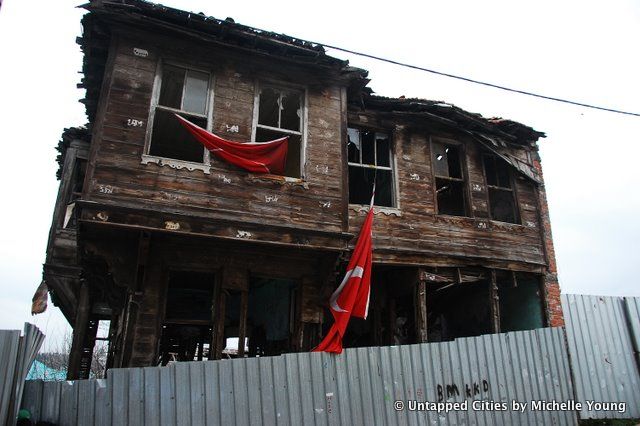
Ottoman Timber home inside the construction site at Sulukule
I spent about ten minutes exploring and photographing, even inside some of the remaining houses. In terms of preservation, the supposed goal of Law 5366, only a handful of the 43 buildings and 11 historical monuments listed as historic remain today, all in a state of severe dilapidation. In 2009, the Sulukule Platform found that “houses registered as historic buildings have been developed and almost all of the listed properties are in no state of conservation due to the detrimental impact of ongoing (demolitions) in the area.” [5] Our first-hand observation of Sulukule confirms this assessment. Most of the remaining homes are in poor condition and without structural intervention, restoration will be challenging. My guess is that the developers are well aware of this and found it convenient to keep the buildings in order to maintain a semblance of abiding the law–demolition by neglect.

The interior of the houses had the look of a place left in a hurry. The kitchen had been fully cleared but clothing was strewn all over the floor. Empty clay flower pots law haphazardly near a window. Old newspapers, straw baskets, shoes, a full bottle of nail polish-all elements of a home, once occupied. And in the center of the house-a vintage upholstered chair-with a t-shirt carefully placed atop one of the arms with the words “SAADET PARTàÆ’ SI” [6] : felicity party. I heard some workers nearby so I scurried out of the house, crossed what was once a local street and back through the crack in the wall.
Mayor Mustafa Demir of Fatih Municipality admitted to us that they made mistakes with Sulukule: “I will make a confession. We are really sorry we relocated the people.” But there is much more to the story, and it goes beyond the jurisdiction of just one local municipality. There are 47 areas in Istanbul targeted for urban renewal, making Law 5366 and the subsequent decision making process that accompanies it, a critical key to development in the city. Mega-projects, such as the $2.5 billion Zorlu Center and Zaha Hadid’s plans for Kartal (6 million square meters), are springing up all over Istanbul. Meanwhile, residents are just starting to understand what citizen participation could mean.
Whether or not the leaders of Istanbul (and Turkey) are prepared, the country is on a precipice. The desire for expression is embodied in the daily protests we witnessed in Istanbul-against the recent government imprisonment of journalists for example. Architecture and urban planning will be key sites of contestation, manifesting the angst of a population in transition. The Turkish are also one of the most virtually connected populations. Turkey is the fourth highest user of Facebook and its users spend nearly as much time online per month as those in the United States. Users are also particularly young, with 70% of the internet audience under the age of 34, compared to 54% globally. One of the recent protests against Web censorship was coordinated online via Google Maps, a virtual march from the capital of Ankara to Istanbul’s Taksim Square:
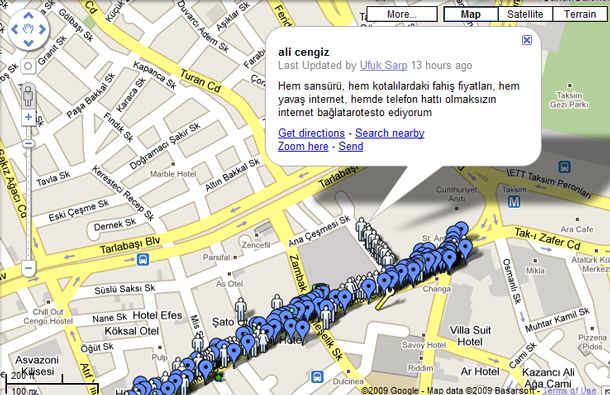
In its push to become one of the “global cities” of the world, what will happen to the built environment in Istanbul? Change is inevitable but what mechanisms can be implemented to enable the voices that are silenced to be heard? Without a legal mechanism of community participation, who will ensure that planning balances the needs of the city with the needs of its current citizens?
Istanbul is unique because it is a city in which the layers of history and the fingerprints of diverse empires are collaged upon each other, both physically in the city and within its people. One cannot understand its nuances from papers or two-dimensional methods alone. But once on its streets, the complexity of space, time, history and politics become palpable. If “rehabilitation” means bulldozing and relocating its citizens to places outside the city, can Istanbul retain the diversity that has made it unique?
Special thanks to Jaeyoung Paek, Yasmin Zaerpoor, Charles-Antoine Perrault, Kevin Selig, Piryanka Jain, Michael Curley, Fred Sham, Markus Dochantschi, Pamela Puchalski, Zuhal Ulusoy (Kadir Has University), Cihan Baysal, Burà§in Altinsay, Aslà”ž ± Kà”ž ±yak à”ž °ngin, Omer Kanipak, Dr. Asu Aksoy (Istanbul Bilgi University Santral), Levent Soysal, GàÆ’ ¼ldem Baykal, Yonca KàÆ’ ¶sebay, Burak Haznedar, Eylem GàÆ’ ¼lcemal and Harun Ekinohlu, for their role in the formulation of these observations both in Istanbul and in New York City.
[1] Joint ICOMOS/UNESCO Expert Mission Report. 6-11 April 2006.
[2] World Heritage Committee/United Nations Educational, Scientific and Cultural Organization Mission Report. 8 to 13 May 2008.
[3]Aslà”ž ± Kà”ž ±yak à”ž °ngin. “Urban Renewal Processes in the Historic City.” 27 to 28 June 2009.
[4] Aslà”ž ± Kà”ž ±yak à”ž °ngin (Human Settlements Association). Sulukule UNESCO Report by the Sulukule Platform. May 2008.
[5] Sulukule Platform. Report on the Impact of Sulukule Urban Renewal Project. 25 April 2009.
Subscribe to our newsletter